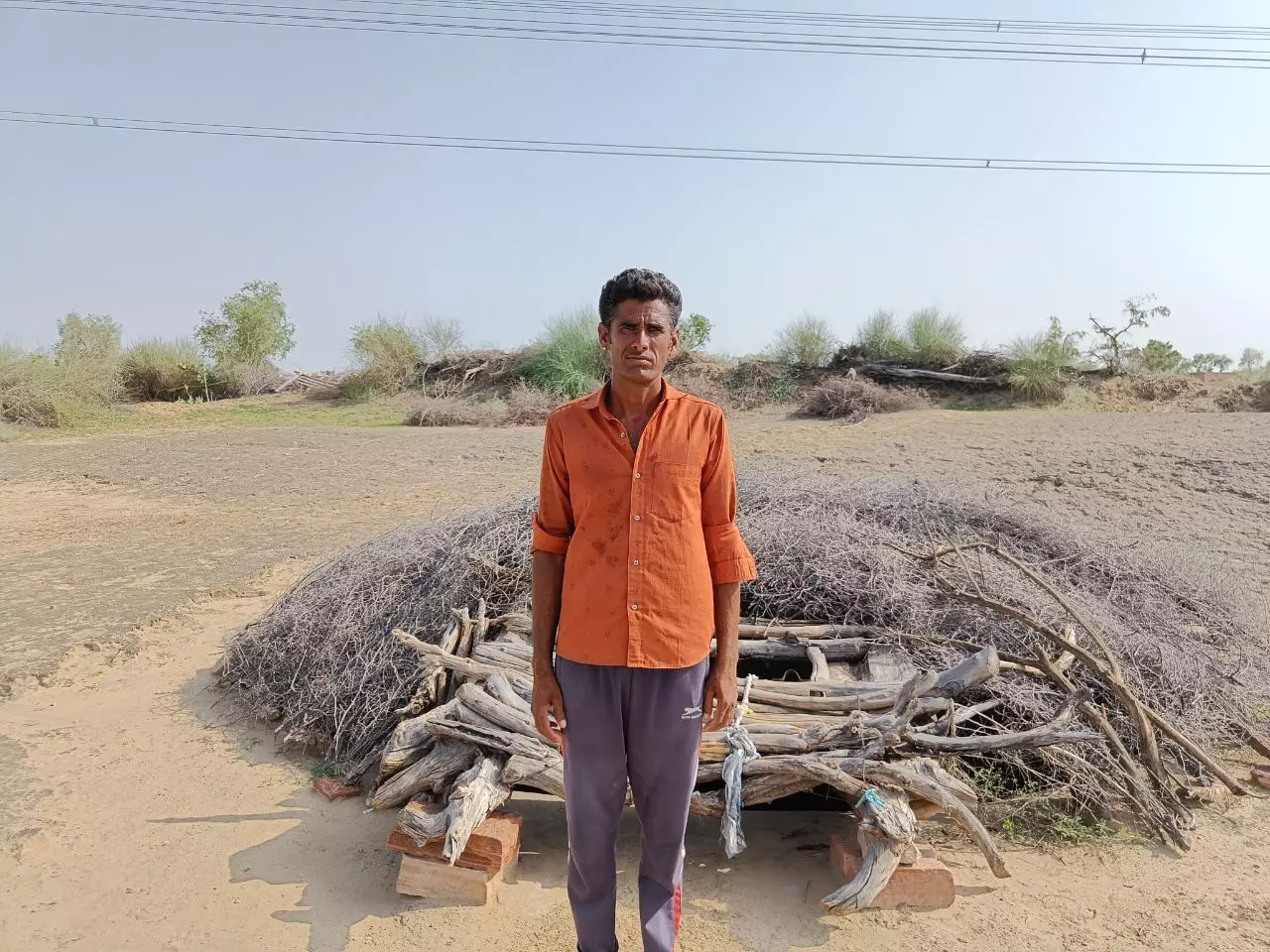Pokhran (Jaisalmer), Rajasthan
Farmer Dhannaram grows bajra, moong and cluster beans on his 50 bighas of land in Abasar, a desert village in Jaisalmer, Rajasthan. For the 38-year-old farmer and his 12 family members, the most precious possession is perhaps the beri on their agricultural land, which meets their drinking water needs throughout the year, including the scorching summer heat of the Thar Desert.
Beri is an underground tank that collects every drop of rainwater which falls in its catchment and stores it for future use. Beri is a part of the ancient water harvesting systems that have evolved over centuries in Rajasthan where rainfall is scanty and water is a precious resource.
“I have two beris that we call paar, and they provide us and our cattle with enough drinking water for an entire year,” Dhannaram told Gaon Connection, whose village is located in Phalsund in Pokhran tehsil.
These ancient water harvesting systems, some of which were built 100 years ago, have stood the test of time and are still functional, inform the local villagers. “A GLR [Ground Level Reservoir] was built by the water department near my home but the last time we saw water there was in 2015, after which it ran dry,” said the farmer, who went on to add that his beri always has water.

Beria is an underground tank that collects every drop of rainwater which falls in its catchment and stores it for future use.
Hot and arid Jaisalmer district receives the least rainfall in the country, and summer temperatures in the desert district are known to cross 47-49 degree Celsius. Therefore, it is not uncommon to see berias in and around agricultural lands in Phalsund.
Rajasthan is known as the land of ancient wisdom of harvesting rainwater, and water conservation efforts of the communities who live in the water-strapped region, have been a way of life for centuries. In many of the villages in Jaisalmer district, berias that were constructed more than 60 years old still function.
A desert village where every house has a beri
There are 400 homes in Prabhupura village in Phalsund tehsil. Each one of them has a beri to collect rainwater.
“The beri is constructed over one bigha of land. We dig about 60 to 70 feet into the sand and layer the base with cement and ashes. We ensure the land slopes towards the beri so that any runoff rainwater collects in it and not even a drop goes waste,” Ashok Chaudhary of Prabhupura village explained to Gaon Connection.

The beria is constructed over one bigha of land. We dig about 60 to 70 feet into the sand and layer the base with cement and ashes.
“These days the beri is covered with a cement lid, but earlier branches of trees, dried grass, etc., were used to do so,” he added.
“Four of the seven berias in my land were built before I was born. We constructed the other three more recently,” said Chaudhary, who is 30 years old.
“The entire drinking water needs of my family is comfortably met by the water in these beri and in the case of a wedding or some function in a household in the village, we share water with them,” said the farmer who farms on 500 bighas of land.
Waiting for piped water supply
While the beria provide potable water for Dhannaram’s family members and their cattle, water for other uses in his house in Abasar village is brought by tankers from the Indira Gandhi Canal, Phalsund.
“We get water from there twice a month. Each tanker full of water costs us Rs 1,000,” the farmer said. Each tanker carries about 4,236 litres of water.
As per the rain gauge register maintained by the tahsildar in Pokhran, between 2004 and 2006, the always-full beri ran dry because of severe drought in the area. As against the annual rainfall of over 200 mm (millimetre) in Jaisalmer district, in the drought year of 2004, the region received 80 mm of rainfall only. But, things improved and water began collecting again in the berias. In 2022, the rainfall was 354 mm, note the records.

As per the rain gauge register, between 2004 and 2006, the always-full beria ran dry because of severe drought in the area.

These days the beria is covered with a cement lid, but earlier branches of trees, dried grass were also used.
As part of the Jal Jeevan Mission of the Ministry of Jal Shakti, pipelines were laid in all the villages in Phalsund. However, the water supply has reached only part of the way till Jeevrajagarh village. Villages beyond that such as Abasar (where Dhanaram lives), Bhurjgarh, Padampura and Prabhupura are yet to get piped water supply.
Gaon Connection tried to contact Mahesh Sharma, Pokhran-based project officer Jal Jeevan Mission, to know more about the progress of the mission in the area, but he did not respond.
Radheyram Rewar, official from the Rural Development and Panchayati Raj Department, Pokhran Sub-division, told Gaon Connection that currently, there are no government-backed water-harvesting programmes in the area.
“Most of the berias made in Prabhupura village have been constructed by the villagers themselves. The community tanks and wells were constructed by gram panchayats and schemes such as the Jal Jeevan Mission,” said Rewar.
Meanwhile, for the communities that make their home in the inhospitable Thar desert, water is life. Centuries old techniques of rainwater harvesting have been creating oases in the desert. Therefore, every generation passes on valuable information and knowledge on water conservation, to the younger generation.
“We do not bat an eyelid if we spill ghee, but wasting even one drop of water is a horror unimaginable for us” is what people there say.


















